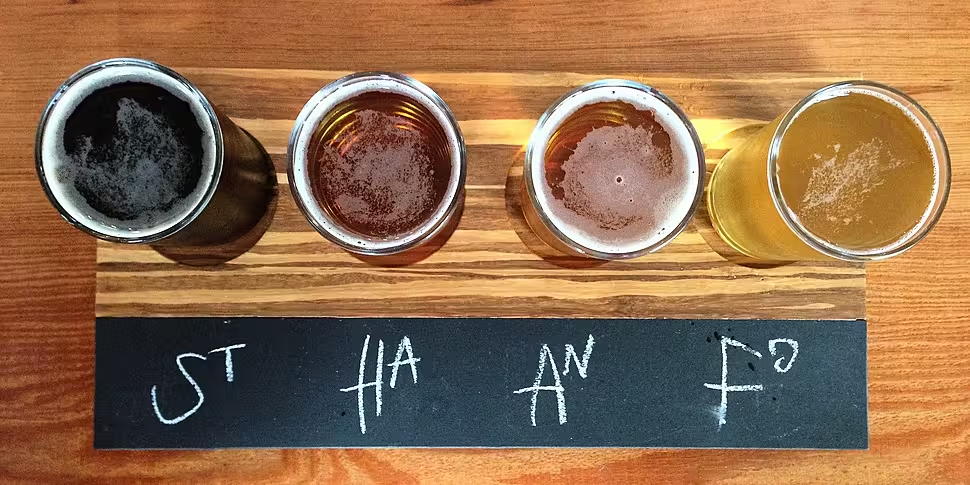Dean McGuinness takes us on a beer journey across Ireland
What does “Community” mean. Today, on Movies and Booze, we are doing our tasting in a slightly different way, and exploring the idea of the Craft Beer Community.
Indie Beer Week is an event celebrating Independent Irish Craft Breweries. It is taking place from Monday 17th May through to Sunday 23rd May. On each of the evenings of Thursday 20th, Fri 21st and Sat 22nd, Indie Beer Week will be running on-line tastings with twenty breweries involved.
The Brewing Companies are –
| Wicklow Brewing Company,
Co. Wicklow |
West Kerry Brewery
Co. Kerry |
Reel Deel Brewery
Co. Mayo |
| Porterhouse Brewing Co.
Dublin |
Trouble Brewing
Co. Kildare |
St. Mel’s Brewery
Co. Longford |
| Metalman Brewing
Co. Waterford |
Lough Gill Brewery
Co. Sligo |
Lineman Beer
Dublin |
| Kinnegar Brewing
Co. Donegal |
Hope Beer
Dublin |
Dungarvan Brewing Company
Co. Waterford |
| Dead Centre Brewing
Co. Westmeath |
Cotton Ball Brewing
Cork |
Canvas Brewery
Co. Tipperary |
| Bru Brewery
Co. Meath |
Black Donkey
Co. Roscommon |
Ballykilcavan
Co. Laois |
| Blacks of Kinsale
Co. Cork |
12 Acres Brewing
Co. Laois |
To-day on Movies and Booze, we are doing the tasting in a slightly different way. We have imposed on our Movie Goddess Esther McCarthy and Radio Presenter Extraordinaire Claire Collins to select two beers from the 26 beers available for the tastings that will be happening from May 20th to 22nd. These are the beers that we are tasting. When we are tasting them we will only identify them by style, and say that they have come from one of the above twenty breweries. At the end of the show, I will name the beers and the brewery from which they have come, but not until then.
Craft Beer Community –
About fourteen years ago, I was visiting breweries in Belgium. In the Grand Place in Brussels, there is a beautiful brewing museum located in the old Brewer’s Guild Building overlooking the square. Following a tour which gives a small presentation about brewing in Belgium, one (by necessity) finds oneself in the tasting room, where two glasses of Belgian beer are served in sequence to the – now quite thirsty – visitor of the brewing museum.
When served my first beer after the tour, I asked the server what beer it was. “It’s a Kriek Lambic”, was the slightly helpful answer that was noticeably lacking in detail. “Which Kriek Lambic?” I asked. “It’s a Belgian Kriek Lambic,” was the response.
Despite determined probing, the server refused to name the brand. “Here in the Brewing Guild, we promote Belgian Beer as a concept, not individual Belgian breweries or brands,” I was told.
This philosophy – this sense of brewing community – extends through the work that the Belgian Brewers Guild (The “Brotherhood of the Brewers’ Mash Staff”) does. Each year, they hold a celebration of Belgian Brewing in the Grand Place. This beer festival allocates space to Belgian Brewers on an equal basis – the largest brewing company in the world gets a stand at the festival identical in size to the smallest brewery at the event, and the location of the stands is randomised every year.
Ireland has an interesting history when it comes to beer. Over the course of the 20th century, one large brewery succeeded, through competition, to almost completely decimate the brewing scene. In the 1700’s there were hundred’s of small breweries operating around the country. Community was at the centre of brewing.
Guinness was established in 1759, and Arthur Guinness died in 1803. One hundred years later, there were only thirty breweries that survived the cut-throat competition that took place in the 19th century. Known worldwide as a country associated with beer, by the time we arrived at the 1980’s we had only three brewing companies operating seven breweries. Following this, two of these brewing companies – Murphy’s and Beamish and Crawford – became one due to a takeover, and Guinness systematically closed down their Irish breweries (and also closed their London brewery at Park Royal in 2005), leaving only St. James Gate.
Other countries that are known for their brewing heritage – such as England, Germany and Belgium – have a plethora of small and regional breweries, each intrinsically associated with the communities in which they are located. This sense of community is important to brewing. For example, in Belgium the brewing conglomerate Inbev (the largest brewing company in the world) attempted, as a cost-cutting measure, to close the Hoegaarden brewery. The protests that resulted verged on revolt. The result was that Inbev had to execute in an embarrassing climb-down and maintain the brewery open. They had to invest substantially to modernise what had become a dated brewery, instead of transferring the brewing capacity to another more modern brewery in a different location. Since the Industrial Revolution, this conflict between commercial competition and community has been intrinsic in beer and brewing.
When we compare brewing in Ireland to other countries, only America is comparable to Ireland in one respect. America and Ireland both experienced unbelievable consolidation and decimation of the sense of community in brewing. In Ireland, this happened as a result of competition, with breweries closed down due to the aggressive competitive tactics of large breweries. In America, it happened through legislation. The Volstead Act (commonly known as Prohibition) made it illegal to produce and sell alcoholic beverages, resulting in breweries and distilleries having to either close down or diversify into non-alcohol related areas. When Prohibition was repealed in 1933, breweries had to re-establish themselves, and the result was that a much smaller number of breweries serviced this large continent.
Craft Brewing grew initially in America. One could argue that an essential element of craft brewing was a desire to return the idea of community to brewing. Many craft brewers were home-brewers – who literally plied their craft for their friends and members of their local community. When they set up breweries, their success grew very much out of this sense of community.
As craft breweries expanded in the U.S., this sense of community was retained. An interesting thing that one notes when one talks to the successful craft brewers in America is how readily they complement and promote the beers brewed by their competitors. When asked in interviews what a craft brewer’s favourite beer is, it is most common for the answer to be something along the lines of – “well, you know I love my own beers, so I doubt that is what you are asking me – these are some beers from other breweries that I think are superb - …. “.
It is wonderful to see that this sense of community is very much in evidence in the craft brewing scene that has emerged in Ireland over the last three decades. This dedication to community is reflected in Indie Beer Week – an upcoming event that is happening from 17th May to 23rd May.
On Thursday 19th May, Friday 20th May and Saturday 21st May, @indieirishbeer and @CraicCommunity are hosting on-line Irish craft beer tastings. Beer tasting packs – consisting of a selection of either six or ten Irish craft beers, depending on the tasting night – can be purchased from @BeerCloudIE. The purchase of a beer kit selection provides the purchaser with a ticket to get engaged in the corresponding on-line tasting that is happening for that kit.
The goal is that, by getting a selection from a range of Irish Craft Breweries, that the Irish beer drinker might come across a beer that becomes their new ‘favourite beer’. Maybe this beer will be from a brewery local to them, or maybe from a brewery on the other end of the country. Either way, by getting involved, people become part of the wider ‘Craft Beer Community’ in Ireland.
Beer No. 1 –
Beer Style - New England IPA, brewed with Red Potato
Alcohol by Volume - 6.4% a.b.v.
This beer presents with a hazy gold appearance, reminiscent of a Belgian Witbier, and true to the New England IPA style.
Immediately, an explosion of fruit character hits the nose from this beer. Peach, mandarin orange, passion fruit, pineapple and grapefruit all combine with lemon citrus and lemon zest. There is a herbal character of pine, mint and eucalyptus, and the balancing bitterness is present but not assertive.
Mouthfeel is luscious and velvety. Probably from a combination of generous dry hopping and the use of red potato in the ingredients, as the flavour of the beer develops on the palate the juicy fruitiness is counterbalanced by a drying tannic quality that acts as a counterpoint. Luscious velvet, juicy acidity, a touch of phenolic character on the palate and a developing subtle bitterness combine to allow the character of this beer to evolve on the palate over time.
This beer is interesting from the point of view of craft beer community. Originally, this beer was brewed as a collaboration brew with Thin Man Brewing in Buffalo in New York. The first time this recipe was brewed was in New York in 2018. This particular beer that we are tasting was brewed in 2021 to the same recipe, but in Ireland. Collaborations like this show that the Craft Beer Community can stretch not only within a country but also across continents.
Beer No. 1 is called ‘Haze Potato Chips’. A New England IPA from Lough Gill Brewery in Sligo. This is a collaboration – originally brewed by Thin Man Brewery in Buffalo, New York in 2018. Red potato accentuates the haze. This batch has been brewed and packaged in Sligo, showing that the craft beer community can extend not only across the country, but also across continents.
Beer No. 2 –
Beer Style - Oatmeal IPA, made with Organic Oats
Alcohol by Volume - 5.5% a.b.v.
This beer pours with a burnished gold, distinctly hazy appearance.
The initial aroma of this beer is an explosion of tropical fruit and citrus fruit character, which follows through into the flavour and taste. Mandarin orange juiciness, pineapple, melon and lime zest are all in evidence in the fruit character of this beer. The balance of this fruit character is superb, and most interesting. Creamy vanilla provides a further dimension to the flavour. A suggestion of bitterness – not assertive – provides balance, and develops into the aftertaste.
The use of Perle hops further balances the fruit character coming from the Simcoe and Mosaic hops – the result is a spice and herbal balancing character that evolves from the hops and the ale fermentation. White pepper, nettles and coriander are all in evidence.
The mouthfeel of this beer is wonderful. Using oats in the grain bill provides a creamy texture to the mouthfeel, and the combination of residual sugars and polyphenols from hop additions results in a full, luscious body and texture. These hop polyphenols provide a tannic drying sensation, which acts as a counterpoint to the juicy fruit hop character, and serves to develop the developing bitterness into the finish. Carbonation is not assertive, and the carbonation beads are fine – the resulting ‘buzz’ on the tongue lifts the luscious, rich velvety body of the beer slightly.
Overall, this beer is exquisitely balanced, and delivers a full fruit character balanced by subdued bitterness and gentle herb and spice flavour in a beer that is full bodied and luscious.
Beer No. 2 is called ‘Marooned’ from Dead Centre Brewing in Athlone – named appropriately given the pandemic and lockdown!! This beer is an Oatmeal IPA, brewed with Organic Kilbeggan Oats. It is contract brewed by 12 Acres Brewing in County Laois, showing how different brewing companies can work together within the craft beer community.
Some other beers from other breweries were also picked out by Esther and Claire, but time does not permit us to taste all of them on Movies and Booze today. Thanks to –
- The Porterhouse, who sent us some samples of ‘Around The Clock’. This is an Imperial Stout. This beer is brewed continuously over 24 hours – boiled for an extended period to concentrate the wort (unfermented beer) so that, when fermented, it can achieve the 12% a.b.v. on the label. It is brewed with seven different types of malt, with seven hop additions and aged in Bourbon and Sherry casks in the Dingle Distillery for 365 days.
- Wicklow Brewery, who sent us some samples of ‘St. Kevin’s Red. This is a classic Irish Red Ale, 4.5% a.b.v., with classic malt character giving bold caramel and toffee flavour with a hint of biscuit balanced with hop bitterness.









